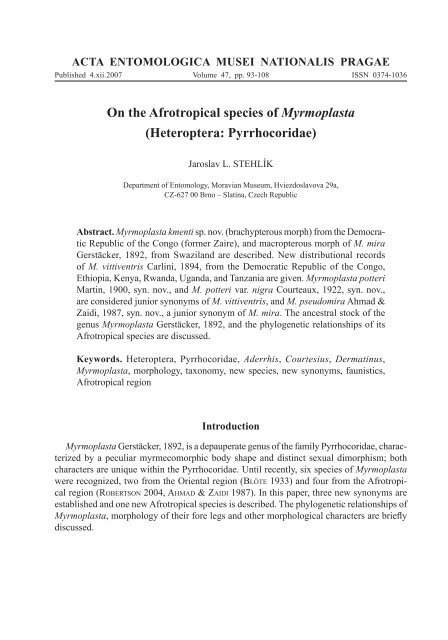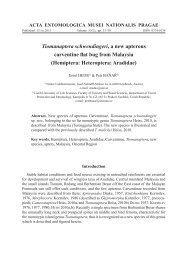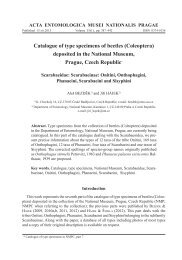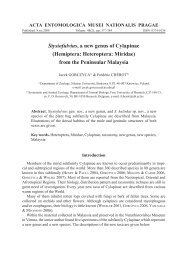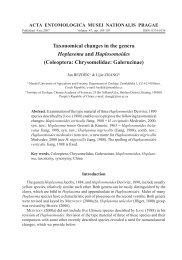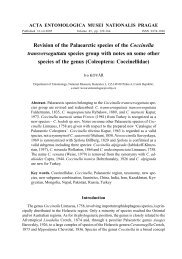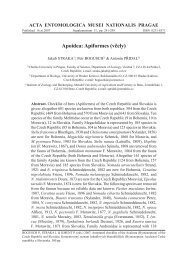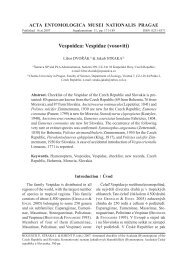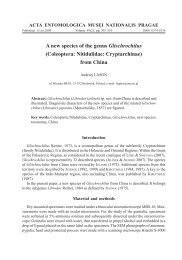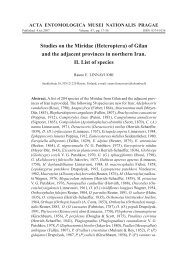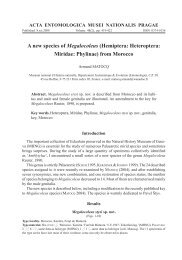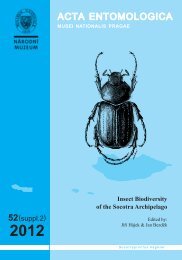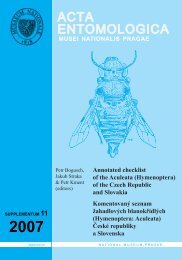On the Afrotropical species of Myrmoplasta - Acta Entomologica ...
On the Afrotropical species of Myrmoplasta - Acta Entomologica ...
On the Afrotropical species of Myrmoplasta - Acta Entomologica ...
You also want an ePaper? Increase the reach of your titles
YUMPU automatically turns print PDFs into web optimized ePapers that Google loves.
ACTA ENTOMOLOGICA MUSEI NATIONALIS PRAGAE<br />
Published 4.xii.2007 Volume 47, pp. 93-108 ISSN 0374-1036<br />
<strong>On</strong> <strong>the</strong> <strong>Afrotropical</strong> <strong>species</strong> <strong>of</strong> <strong>Myrmoplasta</strong><br />
(Heteroptera: Pyrrhocoridae)<br />
Jaroslav L. STEHLÍK<br />
Department <strong>of</strong> Entomology, Moravian Museum, Hviezdoslavova 29a,<br />
CZ-627 00 Brno – Slatina, Czech Republic<br />
Abstract. <strong>Myrmoplasta</strong> kmenti sp. nov. (brachypterous morph) from <strong>the</strong> Democratic<br />
Republic <strong>of</strong> <strong>the</strong> Congo (former Zaire), and macropterous morph <strong>of</strong> M. mira<br />
Gerstäcker, 1892, from Swaziland are described. New distributional records<br />
<strong>of</strong> M. vittiventris Carlini, 1894, from <strong>the</strong> Democratic Republic <strong>of</strong> <strong>the</strong> Congo,<br />
Ethio pia, Kenya, Rwanda, Uganda, and Tanzania are given. <strong>Myrmoplasta</strong> potteri<br />
Martin, 1900, syn. nov., and M. potteri var. nigra Courteaux, 1922, syn. nov.,<br />
are considered junior synonyms <strong>of</strong> M. vittiventris, and M. pseudomira Ahmad &<br />
Zaidi, 1987, syn. nov., a junior synonym <strong>of</strong> M. mira. The ancestral stock <strong>of</strong> <strong>the</strong><br />
genus <strong>Myrmoplasta</strong> Gerstäcker, 1892, and <strong>the</strong> phylogenetic relationships <strong>of</strong> its<br />
<strong>Afrotropical</strong> <strong>species</strong> are discussed.<br />
Keywords. Heteroptera, Pyrrhocoridae, Aderrhis, Courtesius, Dermatinus,<br />
<strong>Myrmoplasta</strong>, morphology, taxonomy, new <strong>species</strong>, new synonyms, faunistics,<br />
<strong>Afrotropical</strong> region<br />
Introduction<br />
<strong>Myrmoplasta</strong> Gerstäcker, 1892, is a depauperate genus <strong>of</strong> <strong>the</strong> family Pyrrhocoridae, characterized<br />
by a peculiar myrmecomorphic body shape and distinct sexual dimorphism; both<br />
characters are unique within <strong>the</strong> Pyrrhocoridae. Until recently, six <strong>species</strong> <strong>of</strong> <strong>Myrmoplasta</strong><br />
were recognized, two from <strong>the</strong> Oriental region (BLÖTE 1933) and four from <strong>the</strong> <strong>Afrotropical</strong><br />
region (ROBERTSON 2004, AHMAD & ZAIDI 1987). In this paper, three new synonyms are<br />
established and one new <strong>Afrotropical</strong> <strong>species</strong> is described. The phylogenetic relationships <strong>of</strong><br />
<strong>Myrmoplasta</strong>, morphology <strong>of</strong> <strong>the</strong>ir fore legs and o<strong>the</strong>r morphological characters are briefl y<br />
discussed.
94<br />
STEHLÍK: <strong>On</strong> <strong>the</strong> <strong>Afrotropical</strong> <strong>species</strong> <strong>of</strong> <strong>Myrmoplasta</strong><br />
Material and Methods<br />
The following codens are used for <strong>the</strong> collections mentioned in this study:<br />
AMNH American Museum <strong>of</strong> Natural History, New York, USA;<br />
BMNH Natural History Museum, London, United Kingdom;<br />
MMBC Moravian Museum, Brno, Czech Republic;<br />
MNHN Muséum National d’Histoire Naturelle, Paris, France;<br />
MRAC Musée Royal d’Afrique Centrale, Tervuren, Belgium;<br />
ZMAN Zoölogisch Museum, University <strong>of</strong> Amsterdam, Ne<strong>the</strong>rlands;<br />
ZMAS Zoological Institute, Russian Academy <strong>of</strong> Sciences, St. Petersburg, Russia;<br />
ZMHB Zoologisches Museum, Humboldt Universität, Berlin, Germany.<br />
Results<br />
<strong>Myrmoplasta</strong> kmenti sp. nov.<br />
(Figs. 1, 3-7)<br />
<strong>Myrmoplasta</strong> mira: SCHOUTEDEN (1957): 266 (misidentifi cation).<br />
Material examined. HOLOTYPE: � (brachypterous), DEMOCRATIC REPUBLIC OF THE CONGO: KINSHASA<br />
PROVINCE, Kisantu, 1932, R. P. Vanderyst (MRAC). PARATYPES (3 ��, brachypterous): DEMOCRATIC REPUBLIC<br />
OF THE CONGO: KINSHASA PROVINCE, Mayidi, 1942, 2 ��, Rév. P. van Eyen (MRAC); ditto, 1945, 1 �, Rév.<br />
P. van Eyen (MRAC).<br />
Description (��, brachypterous morph – Fig. 1). Body black. Posterior margin <strong>of</strong> pronotum<br />
very narrowly bordered with yellow; distal margin <strong>of</strong> hemelytra with narrow yellow border,<br />
slightly widening apicad but not reaching <strong>the</strong> apex <strong>of</strong> shortened hemelytra. Connexival<br />
membrane and, to a varying degree, laterotergites <strong>of</strong> females red. Parameres and lateral rim<br />
infolding on pygophore pale yellow.<br />
Head <strong>of</strong> male (Fig. 3) more horizontally positioned and less convex than in female (Fig. 4).<br />
Antennae <strong>of</strong> male relatively short (missing in all studied females). Antennomere 2 stout,<br />
slightly spindel-shaped; antennomere 3 strongly spindel-shaped (i.e. strongly widening from<br />
base and narrowed before apex), about 1.4 times as thick as antennomere 2; antennomere 4<br />
quite stout, slightly less than 0.8 times as thick as antennomere 3. Gula <strong>of</strong> male only very<br />
slightly convex (in lateral view), in female slightly more convex.<br />
Pronotum long and narrow (Figs. 3-4). Callar lobe (including lateral margins) in male<br />
1.23 times, in females 1.22 times as wide as base <strong>of</strong> pronotum; callar lobe (without pronotal<br />
collar) <strong>of</strong> male 2.3 times, in female 2.5 times as long as pronotal lobe; callar lobe (including<br />
lateral margins) <strong>of</strong> male 1.30 times, <strong>of</strong> female 1.08 times as wide as interocular distance.<br />
Lateral margins <strong>of</strong> callar lobe strongly heart-shaped. Callar lobe distinctly higher than pronotal<br />
lobe (especially in male) and strongly sloping towards it. Pronotum between callar and<br />
pronotal lobe considerably narrowed. Distal part <strong>of</strong> pronotal lobe straight, its proximal part<br />
slightly lifted. Mesoscutellum with distinct median longitudinal furrow, in male 1.16 times,<br />
in female 1.10 times as long as wide. Mesoscutellum fused with hemelytra, <strong>the</strong> latter fused<br />
toge<strong>the</strong>r. Each hemelytron (Figs. 3-4) relatively long, narrow, its margin (except <strong>of</strong> base)<br />
more strongly raised upwards, regularly rounded, a bit narrowed before apex; distal angles
<strong>Acta</strong> <strong>Entomologica</strong> Musei Nationalis Pragae, 47, 2007 95<br />
Fig. 1. <strong>Myrmoplasta</strong> kmenti sp. nov., brachypterous male, holotype (orig. J. Meduna).
96<br />
STEHLÍK: <strong>On</strong> <strong>the</strong> <strong>Afrotropical</strong> <strong>species</strong> <strong>of</strong> <strong>Myrmoplasta</strong><br />
<strong>of</strong> hemelytra slightly produced, convergent, and rounded. Fore femora strongly swollen with<br />
three teeth in male.<br />
Abdomen nearly spherical, strongly constricted basally (Figs. 5-6); tergum considerably<br />
gibbous. Mesotergite II small, mesotergites III-V distinctly large, mesotergite VI <strong>of</strong> male<br />
nearly vertically positioned. Abdomen apically narrowed, mesotergite VII narrow, horizontally<br />
positioned in male, its distal margin bent dorsally. Pygophore not retractable into abdomen<br />
(Fig. 1).<br />
Pygophore. Ventral wall submedially with rounded depression under ventral rim; prominent<br />
longitudinal groove under this depression. Ventral rim only slightly elevated above<br />
Fig. 2. <strong>Myrmoplasta</strong> vittiventris Carlini, 1894, brachypterous male (orig. J. L. Stehlík).
<strong>Acta</strong> <strong>Entomologica</strong> Musei Nationalis Pragae, 47, 2007 97<br />
Figs. 3-7. <strong>Myrmoplasta</strong> kmenti sp. nov. 3-4 – head and thorax, dorsal view: 3 – male; 4 – female. 5-6 – abdomen,<br />
male: 5 – dorsal view; 6 – lateral view. 7 – outer female genitalia.<br />
lateral rims; both ventral and lateral rims with sharp edge, continually and roundly merging<br />
into each o<strong>the</strong>r. Infolding <strong>of</strong> lateral rims very broad, both sides <strong>of</strong> <strong>the</strong>se bent under ventral<br />
rim and nearly contiguous, ventral rim infolding thus not apparent; anterior part <strong>of</strong> lateral<br />
rim infoldings shallowly dish-like deepened, almost horizontal; <strong>the</strong>ir posterior part smaller,<br />
nearly vertically declivous and abruptly narrowed. Parameres placed nearly in <strong>the</strong> middle<br />
<strong>of</strong> genital chamber, <strong>the</strong>ir basal part slightly lopsided medially and than bent over <strong>the</strong> lateral<br />
rim infolding; <strong>the</strong>ir apex narrowed into a tip and very slightly curved. Anal tube positioned<br />
horizontally, reaching nearly <strong>the</strong> parameres.
98<br />
STEHLÍK: <strong>On</strong> <strong>the</strong> <strong>Afrotropical</strong> <strong>species</strong> <strong>of</strong> <strong>Myrmoplasta</strong><br />
Outer female genitalia (Fig. 7). Inner margin <strong>of</strong> valvifer 1 convexly arcuate, reaching<br />
<strong>the</strong> middle <strong>of</strong> genitalia. Anal tube short, closely under tergite VIII. Laterotergite IX raised,<br />
rounded, dish-shaped deepened, with horizontal groove medially. Valvifer 2 visible, medially<br />
deepened, with longitudinal projection laterally on each side; <strong>the</strong>se projections deepened from<br />
<strong>the</strong>ir inner and under side, and apically horizontally ridged.<br />
Measurements. Male (holotype). Body length 6.48 mm. Head: width (including eyes) – 1.84<br />
mm, interocular width – 1.08 mm; antenna: lenght <strong>of</strong> antennomeres 1 – 1.24 mm, 2 – 1.35<br />
mm, 3 – 1.05 mm, 4 – 1.76 mm; pronotum: total length – 1.16 mm, collar lenght – 0.08 mm,<br />
callar lobe: length – 0.76 mm, width (including margins) – 1.40 mm, pronotal lobe: length<br />
– 0.32 mm, width – 1.13 mm; scutellum: length – 0.76 mm, width – 0.65 mm; hemelytron:<br />
length – 1.40 mm, width – 0.59 mm.<br />
Female (paratypes) (mean with full range in paren<strong>the</strong>ses). Body length 7.37 mm (7.13-7.68<br />
mm). Head: width (including eyes) – 2.13 mm (2.05-2.19 mm), interocular width – 1.32 mm<br />
(1.19-1.35 mm); antennae absent in all paratypes; pronotum: total length – 1.25 mm, collar<br />
lenght – 0.11 mm, callar lobe: length – 0.84 mm (0.81-0.86 mm), width (including margins)<br />
– 1.57 mm (1.46-1.62 mm), pronotal lobe: length – 0.29 mm (0.27-0.30 mm), width – 1.28 mm<br />
(1.19-1.35 mm); scutellum: length – 0.93 mm (0.89-0.97 mm), width – 0.83 mm (0.76-0.97<br />
mm); hemelytron: length – 1.37 mm (1.32-1.43 mm), width – 0.63 mm (0.59-0.65 mm).<br />
Variability. No apparent variability was observed among <strong>the</strong> studied specimens, except <strong>the</strong><br />
measurements given above.<br />
Differential diagnosis. <strong>Myrmoplasta</strong> kmenti sp. nov. differs from <strong>the</strong> o<strong>the</strong>r <strong>Afrotropical</strong><br />
<strong>species</strong> <strong>of</strong> <strong>the</strong> genus by characters given in <strong>the</strong> key below.<br />
Etymology. This <strong>species</strong> is dedicated to Petr Kment, curator <strong>of</strong> <strong>the</strong> Hemiptera collection in<br />
National Museum in Prague.<br />
Bionomics. Unknown.<br />
Distribution. Known only from <strong>the</strong> Kinshasa province in <strong>the</strong> Democratic Republic <strong>of</strong> <strong>the</strong><br />
Congo (former Zaire).<br />
<strong>Myrmoplasta</strong> mira Gerstäcker, 1892<br />
(Figs. 8-10)<br />
<strong>Myrmoplasta</strong> mira Gerstäcker, 1892: 51. HOLOTYPE: �, Tanzania, Rosako, Usaramo, August [18]88 (depository<br />
unknown – see Note).<br />
<strong>Myrmoplasta</strong> mira: ROBERTSON (2004): 21 (catalogue).<br />
<strong>Myrmoplasta</strong> pseudomira Ahmad & Zaidi, 1987: 47-49, syn. nov. HOLOTYPE: �, Malvern, 22-1-19, 215 (BMNH).<br />
Type material examined. <strong>Myrmoplasta</strong> pseudomira. HOLOTYPE: �, REPUBLIC OF SOUTH AFRICA: KWAZULU-<br />
NATAL, Malvern, 22-1-19, 215 (BMNH).<br />
Additional material examined. TANZANIA: ZANZIBAR, no fur<strong>the</strong>r data, 1 � (brachypterous) (BMNH). REPUB-<br />
LIC OF SOUTH AFRICA: KWAZULU-NATAL, Ngongoni Veld, 12.ii.1975, 1 � (brachypterous), P. E. Reavell lgt.<br />
(BMNH); Port Shepstone, no fur<strong>the</strong>r data, 1 � (brachypterous) (BMNH). SWAZILAND: Eranchi, xii.1957, 1 �<br />
(macropterous), A. L. Capener leg. (AMNH).<br />
Description <strong>of</strong> macropterous morph (�, Swaziland: Eranchi). Body black, slightly more than<br />
basal two thirds <strong>of</strong> pronotal lobe pale yellow; pale yellow spot anterior <strong>of</strong> apical angle <strong>of</strong> corium<br />
(on costal margin) wide, nearly triangularly narrowed towards <strong>the</strong> inner margin <strong>of</strong> corium,<br />
covering almost one quarter <strong>of</strong> total length <strong>of</strong> corium; laterotergites IV-V yellowish.
<strong>Acta</strong> <strong>Entomologica</strong> Musei Nationalis Pragae, 47, 2007 99<br />
Figs. 8-10. <strong>Myrmoplasta</strong> mira Gerstäcker, 1892, macropterous male. 8 – anterior part <strong>of</strong> body; 9 – thorax, lateral<br />
view; 10 – remigium (rest <strong>of</strong> <strong>the</strong> wing absent).<br />
Head large, vertex strongly convex (Fig. 8). Antennae long, antennomere 1 1.32 times as<br />
long as interocular distance, antennomere 3 as long as <strong>the</strong> interocular distance; antennomere<br />
1 more strongly widened towards apex, antennomere 2 more slightly widened, antennomere<br />
3 distinctly widened towards apex (but not spindel-shaped). Bucculae large and high.<br />
Pronotal collar (in lateral view, Fig. 9) distinctly lowered below callar lobe; pronotal lobe<br />
strongly convex above <strong>the</strong> level <strong>of</strong> callar lobe, strongly widened laterad (in dorsal view) and<br />
slighly lowered next to humeral humps, at base 1.56 times as wide as callar lobe (including<br />
lateral margins), 1.18 times as long as callar lobe (without pronotal collar). Base <strong>of</strong> pronotum<br />
1.58 times as wide as pronotum long. Lateral margins <strong>of</strong> pronotum only slightly narrowing<br />
towards base. Scutellum large. Hemelytra with clavus and membrana well-developed; costal<br />
margin <strong>of</strong> corium more strongly arched outwards, its distal margin rounded towards apex.<br />
Delimitation <strong>of</strong> corium and membrane less apparent, especially in distal angle; clavus and<br />
corium roughly and hardly regularly punctured. Hind wings (Fig. 10) fully developed, slightly<br />
surpassing base <strong>of</strong> tergite VII; hamus not developed. Veins R, M, and Cu protruding in regular<br />
distances, with closed cell formed by R and Cu (only remigium <strong>of</strong> <strong>the</strong> wing preserved,
100<br />
STEHLÍK: <strong>On</strong> <strong>the</strong> <strong>Afrotropical</strong> <strong>species</strong> <strong>of</strong> <strong>Myrmoplasta</strong><br />
o<strong>the</strong>r parts missing). Mesosternum strongly developed, pleuron I strongly gibbous, posterior<br />
pleural fl ange quite wide.<br />
Abdominal tergites with long, nearly erect setae, <strong>the</strong> latter developed even if covered with<br />
hemelytra.<br />
Measurements. Body length 7.45 mm. Head: width (including eyes) – 2.00 mm, interocular<br />
width – 1.19 mm; antenna: lenght <strong>of</strong> antennomeres 1 – 1.57 mm, 2 – 1.62 mm, 3 – 1.19<br />
mm, 4 – 1.78 mm; pronotum: total length – 1.40 mm, collar lenght – 0.11 mm, callar lobe:<br />
length – 0.59 mm, width (including margins) – 1.42 mm, pronotal lobe: length – 0.70 mm,<br />
width – 2.21 mm; scutellum: length – 1.19 mm, width – 1.19 mm; corium: length – 2.70<br />
mm, width – 1.19 mm.<br />
Variability. Measurements <strong>of</strong> brachypterous morph. Males (from Zanzibar / Natal, Port<br />
Shepstone). Body length 7.40 mm / 7.18 mm. Head: width (including eyes) – 2.05 mm / 2.08<br />
mm, interocular width – 1.30 mm / 1.24 mm; antenna: lenght <strong>of</strong> antennomeres 1 – 1.62 mm /<br />
1.57 mm, 2 – 1.57 mm / 1.51 mm, 3 – 1.24 mm / 1.08 mm, 4 – 1.94 mm / 1.84 mm; pronotum:<br />
total length – 1.35 mm / 1.19 mm, width <strong>of</strong> base – 1.35 mm / 1.30 mm, callar lobe width<br />
– 1.54 mm / 1.46 mm; scutellum: length – 0.92 mm / 0.92 mm, width – 0.78 mm / 0.81 mm;<br />
hemelytron: length – 1.30 mm / 1.19 mm, width – 0.65 mm / 0.59 mm.<br />
Females (holotype <strong>of</strong> M. pseudomira from Malvern / specimen from Natal, N Gongony<br />
Veld). Body length 8.26 mm / 9.18 mm. Head: width (including eyes) – 2.32 mm / 2.32 mm,<br />
interocular width – 1.51 mm / 1.51 mm; antenna: lenght <strong>of</strong> antennomeres 1 – 1.73 mm /<br />
1.73 mm, 2 – 1.62 mm / 1.84 mm, 3 – 1.24 mm / 1.35 mm, 4 – missing / 1.94 mm; pronotum:<br />
total length – 1.35 mm / 1.54 mm, width <strong>of</strong> base – 1.51 mm / 1.46 mm, callar lobe width<br />
– 1.67 mm / 1.78 mm; scutellum: length – 0.81 mm / 0.86 mm, width – 0.81 mm / 0.92 mm;<br />
hemelytron: length – 0.86 mm / 0.97 mm, width – 0.59 mm / 0.59 mm.<br />
Antennomeres 1 and 2 are subequal in length, and antennomere 1 is sometimes slightly<br />
longer than antennomere 2.<br />
Comparative note. This <strong>species</strong> was previously known only in <strong>the</strong> brachypterous morph.<br />
The macropterous morph <strong>of</strong> M. mira resembles <strong>the</strong> macropterous morph <strong>of</strong> M. vittiventris<br />
Carlini, 1894, from which it is easily separated by <strong>the</strong> coloration <strong>of</strong> abdominal venter (in M.<br />
mira entirely black, in M. vittiventris black with yellow spots), pronotal lobe (in M. mira<br />
only ca. basal 2/3 yellow, in M. vittiventris entirely yellow), and dorsal tergites (in M. mira<br />
black, in M. vittiventris yellow).<br />
Taxonomy. Revision <strong>of</strong> <strong>the</strong> type material <strong>of</strong> M. pseudomira revealed that it is merely a junior<br />
synonym <strong>of</strong> M. mira. The original description <strong>of</strong> M. pseudomira by AHMAD & ZAIDI (1987)<br />
is not very precise. The following points should be noted: i) antennomeres 1 and 2 are not<br />
equally long, but antennomere 1 is slightly longer than antennomere 2 (see measurements <strong>of</strong><br />
<strong>the</strong> holotype) as in M. mira (GERSTÄCKER (1892): ‘articulo primo secundo parum longiore’<br />
[= fi rst segment only slightly longer than second]); ii) base <strong>of</strong> hind femur is not black but<br />
whitish as in M. mira; iii) in <strong>the</strong> habitus fi gure <strong>of</strong> female by AHMAD & ZAIDI (1987), <strong>the</strong> fore<br />
femora are very slender, although stout fore femora with a ridge on <strong>the</strong> dorsal margin <strong>of</strong> <strong>the</strong><br />
depression are a general character <strong>of</strong> <strong>the</strong> genus <strong>Myrmoplasta</strong> (see below); <strong>the</strong> fore femora<br />
<strong>of</strong> male are not edentate but possess three stout, distant teeth on a ridge; iv) <strong>the</strong> fi gure <strong>of</strong><br />
female outer genitalia in AHMAD & ZAIDI (1987) is apparently incorrect, showing artifi cial
<strong>Acta</strong> <strong>Entomologica</strong> Musei Nationalis Pragae, 47, 2007 101<br />
structures. Moreover, <strong>the</strong> numbers <strong>of</strong> all fi gures in AHMAD & ZAIDI (1987) do not correspond<br />
with <strong>the</strong> fi gure captions.<br />
Distribution. Republic <strong>of</strong> South Africa (Kwazulu-Natal) (AHMAD & ZAIDI 1987); Swaziland<br />
(new record); Tanzania (GERSTÄCKER 1892), including Zanzibar (new record).<br />
AHMAD & ZAIDI (1987) described M. pseudomira from Malvern, which <strong>the</strong>y placed in<br />
eastern Africa. However, this locality is in fact situated in <strong>the</strong> province <strong>of</strong> Kwazulu-Natal<br />
in <strong>the</strong> Republic <strong>of</strong> South Africa. <strong>Myrmoplasta</strong> pseudomira was omitted in <strong>the</strong> catalogue <strong>of</strong><br />
<strong>Afrotropical</strong> Pyrrhocoroidea by ROBERTSON (2004).<br />
ROBERTSON (2004) listed M. mira also from <strong>the</strong> Democratic Republic <strong>of</strong> <strong>the</strong> Congo and<br />
Ethiopia. However, <strong>the</strong> records from <strong>the</strong> Democratic Republic <strong>of</strong> <strong>the</strong> Congo (SCHOUTEDEN<br />
1957) belong to M. kmenti sp. nov., and records from Ethiopia (SCHMIDT 1932) belong to<br />
M. vittiventris.<br />
Note. According to HORN (1926, 1929), <strong>the</strong> Gerstäcker’s collection should be deposited in<br />
ZMBH and <strong>the</strong> Zoological Museum <strong>of</strong> Ernst-Moritz-Arndt-Universität (Greifswald, Germany).<br />
Jürgen Deckert (ZMBH, pers. comm.) informed me that <strong>the</strong> holotype is not housed in ZMBH.<br />
Unfortunately, I did not recieve any response from Greifswald, and <strong>the</strong> type depository thus<br />
remains uncertain.<br />
<strong>Myrmoplasta</strong> vittiventris Carlini, 1894<br />
(Figs. 2, 11-16)<br />
<strong>Myrmoplasta</strong> vittiventris Carlini, 1894: 471. HOLOTYPE: �, [Uganda], Nkole, cap. Casati leg., 1888 (depository<br />
unknown).<br />
<strong>Myrmoplasta</strong> potteri Martin, 1900: 21-22, syn. nov. SYNTYPES: 1 � and more ��, Abyssinie [= Ethiopia], M. Maurice<br />
leg. (MNHN).<br />
<strong>Myrmoplasta</strong> potteri var. nigra Courteaux, 1922: 286, pl. xxvii, syn. nov. HOLOTYPE: �, [Ethiopia], Lac Abbaï<br />
(?MNHN – see Note).<br />
<strong>Myrmoplasta</strong> potteri: DISTANT (1909): 79 (distribution); BLÖTE (1931): 115 (distribution); IZZARD (1950): 192-194<br />
(description <strong>of</strong> macropterous morph, distribution); MANCINI (1956): 79 (distribution); SCHOUTEDEN (1957): 266<br />
(distribution); LINNAVUORI (1978): 8 (distribution, ecology); LINNAVUORI (1980): 29 (distribution); ROBERTSON<br />
(2004): 21 (catalogue).<br />
<strong>Myrmoplasta</strong> mira (misidentifi cation): SCHMIDT (1932): 257 (distribution).<br />
<strong>Myrmoplasta</strong> vittiventris: ROBERTSON (2004): 22 (catalogue).<br />
Material examined. MACROPTEROUS SPECIMEN. UGANDA: Kawanda, 7.v.1943, 1�, H. D. Mubbiru lgt., B.M. 1948-<br />
548, R. J. Izzard 1944 det. as M. potteri (BMNH). BRACHYPTEROUS SPECIMENS. DEMOCRATIC REPUBLIC OF<br />
THE CONGO: EAST, ITURI PROVINCE, Bunia, vi.1938, 1 � 2 ��, P. Lefèvre leg. (MRAC); Mahagi Port, 1929, 1 �,<br />
Ch. Scops leg. (MRAC); Abock, 8.iii.1929, 1 �, A. Collart leg. (MRAC). SUD KIVU PROVINCE, Mulungu – Tshibinda,<br />
xi.1951, 2 �� 4 ��, P. C. Lefèvre leg. (MRAC); BAS-UELÉ PROVINCE, Dingila, 1935, 1 �, J. V. Leroy leg. (MRAC).<br />
ETHIOPIA: ‘Süd-Aethiopien, Abasse, O. Neumann S.’, 1 �; ‘Süd-Aethiopien, Habela, O. Neumann S.’, 1 �;<br />
‘Süd-Aethiopien, Svhubba, O. Neumann S.’, 1 �; ‘N. Galla, 14.xii.1900, v. Erlanger S. G.’, 1 �; ‘Galla. Somali,<br />
v. Erlanger S. G.’; all material published by SCHMIDT (1932) as M. mira, J. L. Stehlík revid. (ZMHB). KENYA:<br />
ARUSHA PROVINCE, Makuyu, B.M. 1937-529, 1.ii.1937, 1 � 1 �, C. D. Knight lgt. (BMNH). RWANDA: Kisenyi,<br />
1947, 1 �, P. C. Lefèvre leg. (MRAC); Astrida Ginda, 1700 m a.s.l., 12.-15.iv.1950, 1 �, R. Laurent leg. (MRAC);<br />
Mutambu Tare, 1750 m a.s.l., 11.-15.iv.1950, 1 �, R. Laurent leg. (MRAC); Ndiza, Kabuye, 2000 m a.s.l., iv.1951,<br />
1 �, A. E. Bertrand leg. (MRAC); Kibungu, x.-xii.1937, 1 � 1 �, R. Verhulst leg. (MRAC). TANZANIA: KAGERA<br />
REGION, Bukoba district, Bukoba, 8.vi.1913, 1 �, Troitzkij leg. (ZMAS); ditto, Lake Ikimba, 7.vii.1913, 1 �, Troitzkij<br />
leg. (ZMAS). Mwanze region, Mwanza district, Mwanza, 18.-19.i.1968, 1 � 1 �, D. Gulissen & L. Blommers leg.<br />
(ZMAN). UGANDA: BUGANDA PROVINCE, Mengo district, Kawanda, 9.viii.1956, 1 �, T. H. Odhiambo leg. (MMBC).
102<br />
STEHLÍK: <strong>On</strong> <strong>the</strong> <strong>Afrotropical</strong> <strong>species</strong> <strong>of</strong> <strong>Myrmoplasta</strong><br />
EASTERN PROVINCE, Teso district, Serere, on Dolichos, xi.1956, 2 ��, T. R. Odhiambo leg. (MMBC). WESTERN PRO-<br />
VINCE, Toro district, Ituri Forest, 9.iv.1957, 1 �, T. R. Odhiambo leg. (MMBC); Bunyoro district, Valley <strong>of</strong> Kafu<br />
R.[iver], Unyoro, 3400 ft., 23.-28.xii.1911, 1 �, S. A. Neave leg. (BMNH);<br />
Variability. None <strong>of</strong> <strong>the</strong> preceding authors, except <strong>of</strong> a short note by ROBERTSON (2004),<br />
mentioned <strong>the</strong> sexually dimorphic coloration <strong>of</strong> ventrites in M. vittiventris. Thus, I give here<br />
a detailed description and illustration.<br />
Male (Fig. 15). Ventrites black, large yellow spots laterally on ventrites II and III, sometimes<br />
also a small, vaguely delimited spot on ventrite IV. Spots on ventrites II and III nearly reaching<br />
lower margins <strong>of</strong> laterotergites II and III; spot on ventrite II elongated, nearly triangular; spot<br />
on ventrite III nearly square, its lower margin reaching ca. mid-height <strong>of</strong> ventrite.<br />
Female (Fig. 16). Ground coloration <strong>of</strong> ventrites black, with large yellowish spots on<br />
ventrites II-VI. Spots on ventrites II and III reaching lower margin <strong>of</strong> laterotergites II and<br />
III, considerably elongated and sickle-shaped ventrally; wide yellowish bands on ventrites<br />
IV-VI situated only on zygosternites (not reaching lower margins <strong>of</strong> laterotergites) and not<br />
connected medially toge<strong>the</strong>r, closer to distal than proximal margins <strong>of</strong> zygosternites.<br />
A colour aberration described by COURTEAUX (1922), M. potteri var. nigra, has mesotergites<br />
black and laterotergites ferruginous.<br />
I had <strong>the</strong> possibility to examine <strong>the</strong> macropterous female described by IZZARD (1950). The<br />
following two statements should be added to IZZARD’s (1950) description: i) tergites under<br />
hemelytra <strong>of</strong> macropterous morph bright yellow, only incisurae between tergites black (tergites<br />
red in brachypterous morph); ii) tergites <strong>of</strong> macropterous morph completely fl at, without setae<br />
(arched and setous in brachypterous morph). The macropterous morph occurs rarely in both<br />
sexes; SCHOUTEDEN (1957) noted one macropterous male and one female.<br />
Bionomics. In Uganda, this <strong>species</strong> was collected on Dolichos sp. (this paper). The hyacinth<br />
bean (Dolichos lablab L.) (Fabaceae) is an edible plant cultivated in tropical Africa. LINNA-<br />
VUORI (1978) reported this <strong>species</strong> to be swept from dry sunny meadows.<br />
Distribution. This <strong>species</strong> has a relatively small area <strong>of</strong> distribution around <strong>the</strong> nor<strong>the</strong>rn part<br />
<strong>of</strong> East African Rift Valley. It is known from Ethiopia (MARTIN (1900) – no exact locality;<br />
COURTEAUX (1922) – environs <strong>of</strong> Abaya Hayk lake in south-western Ethiopia; SCHMIDT (1932,<br />
as M. mira – J. L. Stehlík revid.) – sou<strong>the</strong>rn Ethiopia; MANCINI (1956) – several localities in<br />
south-eastern Ethiopia), Sudan (LINNAVUORI (1978) – central part <strong>of</strong> <strong>the</strong> Equatoria province),<br />
Kenya (ROBERTSON (2004) – no exact locality), Uganda (CARLINI (1894) and BLÖTE (1931)<br />
– Western province, Nkole [= Ankole] district; DISTANT (1909) – Toro district; IZZARD (1950)<br />
– Buganda province, Mengo district), Tanzania (BLÖTE (1931) – Kagera [= Karagwe] region),<br />
Burundi (SCHOUTEDEN (1957) – more localities), Rwanda (SCHOUTEDEN (1957) – more localities),<br />
and <strong>the</strong> Democratic Republic <strong>of</strong> <strong>the</strong> Congo (SCHOUTEDEN (1957) – ‘…l’est du Congo’,<br />
without any exact locality; confi rmed in this paper). SCHMIDT (1932) mentioned fi ve females<br />
originally identifi ed as M. mira from ‘Süd-Aethiopien [= sou<strong>the</strong>rn Ethiopia] (O. Neumann S.)’.<br />
Revision <strong>of</strong> this material revealed that this material originated from fi ve different localities,<br />
three <strong>of</strong> which are undoubtedly situated in Ethiopia. However, I could not trace localities ‘N.<br />
Galla’ and ‘Galla. Somali’; both Galla and Somali are names <strong>of</strong> native tribes living both in<br />
Ethiopia and Somalia. Thus, <strong>the</strong> occurrence <strong>of</strong> M. vittiventris in Somalia cannot be excluded;<br />
however, no exact record was ever published from this country (see LINNAVUORI 1982, 1986;<br />
ROBERTSON 2004). LINNAVUORI (1980) classifi ed this <strong>species</strong> as east-sudanese element.
<strong>Acta</strong> <strong>Entomologica</strong> Musei Nationalis Pragae, 47, 2007 103<br />
Figs. 11-16. <strong>Myrmoplasta</strong> vittiventris Carlini, 1894. 11-12 – head and thorax, dorsal view: 11 – male; 12 – female.<br />
13-14 – abdomen, male: 13: dorsal view; 14 – lateral view. 15-16 – abdomen, lateral view, coloration: 15 – male;<br />
16 – female.<br />
Taxonomy. ROBERTSON (2004), comparing <strong>the</strong> original descriptions <strong>of</strong> M. vittiventris and<br />
M. potteri, mentioned <strong>the</strong> possible synonymy <strong>of</strong> both <strong>species</strong> but did not establish it. Here I<br />
am confi rming his statement that M. potteri is a junior synonym <strong>of</strong> M. vittiventris. Original<br />
descriptions <strong>of</strong> both <strong>species</strong> are identical. According to CARLINI (1894), M. vittiventris lacks any<br />
pubescence, except <strong>of</strong> <strong>the</strong> ventral side <strong>of</strong> fore legs. However, <strong>the</strong> pubescence <strong>of</strong> <strong>the</strong> head and
104<br />
STEHLÍK: <strong>On</strong> <strong>the</strong> <strong>Afrotropical</strong> <strong>species</strong> <strong>of</strong> <strong>Myrmoplasta</strong><br />
<strong>the</strong> setae on mesotergites break <strong>of</strong>f easily, especially in badly conserved specimens. Moreover,<br />
<strong>the</strong> presence <strong>of</strong> pubescence on mesotergites is a generic character <strong>of</strong> <strong>Myrmoplasta</strong>. MARTIN<br />
(1900) probably did not know <strong>the</strong> description <strong>of</strong> M. vittiventris, which has <strong>the</strong> same coloration,<br />
and compared his M. potteri only with <strong>the</strong> distinctly differently coloured M. mira.<br />
<strong>Myrmoplasta</strong> potteri var. nigra is undoubtedly an infrasubspecifi c colour form and thus<br />
an unavailable name.<br />
Note. The type depositoty <strong>of</strong> M. vittiventris is unknown. There is no information about location<br />
<strong>of</strong> Carlini’s collection in <strong>the</strong> lists by HORN (1926, 1929) and SACHTLEBEN (1961). COURTEAUX<br />
(1922) described M. potteri var. nigra based on a female collected by expedition <strong>of</strong> Baron<br />
Maurice de Rothschild in Ethiopia and British Eastern Africa (1904-1905). According to<br />
HORN (1929), this material was deposited in MNHN in Paris. However, D. Pluot-Sigwalt<br />
(pers. comm.) did not fi nd it <strong>the</strong>re.<br />
Key to <strong>the</strong> <strong>Afrotropical</strong> <strong>species</strong> <strong>of</strong> <strong>Myrmoplasta</strong><br />
1 (2) Coloration <strong>of</strong> ventrites sexually dimorphic; ventrites black with yellow spot on ventrite<br />
II and III in males (Fig. 15) and with yellow bands on ventrites II-VI in females (Fig.<br />
16). Pronotal lobe entirely yellow in both brachypterous (Fig. 2) and macropterous<br />
morph. ............................................................................... M. vittiventris Carlini, 1894<br />
2 (1) Coloration <strong>of</strong> ventrites not sexually dimorphic, ventrites entirely black; in brachypterous<br />
morph only posterior margin <strong>of</strong> pronotal lobe yellow (Fig. 11). ..................................3<br />
3 (4) Base <strong>of</strong> metafemora yellowish (Fig. 2). Pygophore retractable. Distal part <strong>of</strong> tergite<br />
VII slightly raised, its lateral margins more strongly tapering, its distal margin slightly<br />
arcuate (Figs. 13-14). Laterotergites <strong>of</strong> female black. Body larger (male 7.18-7.40 mm,<br />
female 8.26-9.18 mm). Antennae longer (6.05-6.86 mm in male). Laterotergites IV and<br />
V yellowish. Apex <strong>of</strong> hemelytra in brachypterous morph less prolonged (1.19-1.30 mm<br />
in male, 0.86-0.97 mm in female). ..................................... M. mira Gerstäcker, 1892<br />
4 (3) Metafemora black. Pygophore not retractable, abdominal segment VII reduced (Fig. 1).<br />
Distal part <strong>of</strong> tergite VII more risen, its lateral margins proximally slightly defl ected,<br />
distally almost parallel, its posterior margin straight (Figs. 5-6). Body smaller (male<br />
6.48 mm, female 7.13-7.68 mm). Antennae shorter (4.40 mm in male). Laterotergites<br />
<strong>of</strong> female red. Apex <strong>of</strong> hemelytra in brachypterous morph more prolonged (1.40 mm<br />
in male, 1.32-1.43 mm in female). ................................................. M. kmenti sp. nov.<br />
Fore leg morphology <strong>of</strong> Aderrhis, Courtesius, Dermatinus, and <strong>Myrmoplasta</strong><br />
Although <strong>the</strong> shape <strong>of</strong> <strong>the</strong> fore legs is an important taxonomic character, it was so far<br />
insuffi ciently described, especially with respect to <strong>the</strong> sexual dimorphism. Therefore, I give<br />
here diagnoses <strong>of</strong> <strong>the</strong> fore leg morphology for all four genera.<br />
Dermatinus Stål, 1854. Fore legs not sexually dimorphic; fore femora with deeper depression<br />
on ventral side (except <strong>of</strong> <strong>the</strong>ir apical parts), dorsal margin <strong>of</strong> this depression slightly<br />
higher; one tooth anteapically on dorsal margin (plesiomorphic character). Fore tibiae straight,<br />
without denticles on its ventral side.
<strong>Acta</strong> <strong>Entomologica</strong> Musei Nationalis Pragae, 47, 2007 105<br />
Aderrhis Bergroth, 1906. Fore legs strongly sexually dimorphic. �: Fore femora constricted<br />
basally, <strong>the</strong>n strongly and abruptly ventrally thickened with large tooth; ventral depression on<br />
fore femur shallow, its dorsal edge only slightly indicated, its ventral edge forming gibbous<br />
ridge with small regular denticles; depression covered with sparse, very long, thin, and almost<br />
orthogonally directed setae ordered into a regular row. Fore tibiae incurved, postero-ventrally<br />
with row <strong>of</strong> regular setiferous denticles. �: Fore femora without abrupt thickening and<br />
without tooth, almost without ventral depression, but with a row <strong>of</strong> long setae (apomorphic<br />
character). Fore tibiae straight, without postero-ventral denticles.<br />
Courtesius Distant, 1903. Fore femora <strong>of</strong> both sexes robust, basally narrowed. Longitudinal<br />
depression shallow, its dorsal margin in both sexes with three distant teeth spaced along nearly<br />
entire length <strong>of</strong> femur (except <strong>of</strong> apices) (<strong>the</strong> same arrangement as in males <strong>of</strong> <strong>Myrmoplasta</strong>);<br />
teeth larger in males than in females. Spaces between teeth with setae, some <strong>of</strong> <strong>the</strong>m arising<br />
from very small denticles. Fore tibiae straight, without postero-ventral denticles.<br />
<strong>Myrmoplasta</strong>. Fore legs sexually dimorphic. �: Fore femora strongly narrowed basally, <strong>the</strong>n<br />
very abruptly thickened on ventral side with large tooth on <strong>the</strong> thickened place. Depression<br />
on ventral margin <strong>of</strong> femur almost indistinct, its dorsal edge (opposite than in Aderrhis!) with<br />
a high ridge armed with three teeth, one basal and two apparently larger ones; one situated<br />
approximately in middle <strong>of</strong> femur and ano<strong>the</strong>r one in basal two thirds. Ridge (not <strong>the</strong> depression)<br />
with conspicuously stout, projecting, somewhat irregularly arranged setae. Fore tibiae<br />
infl exed basally, lacking minute denticles ventrally, only with a row <strong>of</strong> short, stout, densely<br />
spaced, adpressed setae. �: Fore femora regularly swollen from base, on antero-ventral side<br />
with a ridge (not as high as in males); minute denticles in places where males possess <strong>the</strong><br />
stout teeth. Fore tibiae straight. Pubescence <strong>of</strong> <strong>the</strong> ridge and fore tibiae as in males.<br />
Discussion<br />
The phylogeny <strong>of</strong> <strong>the</strong> morphologically higly specialized, myrmecomorphic body structures<br />
in <strong>the</strong> genus <strong>Myrmoplasta</strong> <strong>of</strong>fers interesting questions. Undoubtedly, this genus developed<br />
from an ancestral stock characterised by large eyes without eye sockets and a high tendency<br />
for brachyptery (i.e. brachypterous morphs without rudiments <strong>of</strong> membrana, clavus fused with<br />
corium). Except <strong>of</strong> <strong>Myrmoplasta</strong>, this stock contains also <strong>the</strong> genera Dermatinus, Aderrhis,<br />
and Courtesius.<br />
The following characters seem to be plesiomorphic: slight sexual dimorphism in <strong>the</strong><br />
structure <strong>of</strong> fore legs; distinctly trapezoidal pronotum; callar lobe emarginated by deeper<br />
impressions or pronounced punctuation (characteristic feature <strong>of</strong> most genera within <strong>the</strong><br />
Pyrrhocoridae); abdomen basally broad; fl at mesotergites without sparse, erect, long setae;<br />
and hemelytra distinctly surpassing basal part <strong>of</strong> abdomen. <strong>On</strong> <strong>the</strong> o<strong>the</strong>r hand, <strong>the</strong> following<br />
characters are supposed to be apomorphic: strongly sexually dimorphic fore legs (male with<br />
a lamellar ridge on <strong>the</strong> ventral side and with strong teeth near <strong>the</strong> base <strong>of</strong> femur and incurved<br />
tibia, or with a lamellar ridge with three strong teeth on <strong>the</strong> dorsal side <strong>of</strong> femur); deep constriction<br />
between callar and pronotal lobes; basally constricted abdomen; strongly gibbous<br />
mesotergites with sparse, long, erect setae; hemelytra shortened, only slightly surpassing<br />
metanotum, fused with mesoscutellum.
106<br />
STEHLÍK: <strong>On</strong> <strong>the</strong> <strong>Afrotropical</strong> <strong>species</strong> <strong>of</strong> <strong>Myrmoplasta</strong><br />
Dermatinus and Aderrhis are characterized, among o<strong>the</strong>r characters, by a smaller and (especially<br />
in Dermatinus) horizontally directed head. Their pronotum is more or less trapezoidal,<br />
usually almost fl at, and with only a very indistinctly indicated callar lobe. The collar and<br />
lamellar margins <strong>of</strong> <strong>the</strong> pronotum are only slightly differentiated. The head <strong>of</strong> <strong>Myrmoplasta</strong>,<br />
compared with Courtesius, is even more enlarged and its anterior part is more bowed. The<br />
constriction between <strong>the</strong> callar and pronotal lobe is even more distinct. Ano<strong>the</strong>r evolutionary<br />
trend within <strong>Myrmoplasta</strong> is <strong>the</strong> shortening <strong>of</strong> hemelytra. This tendency is supported by <strong>the</strong><br />
existence <strong>of</strong> two Oriental <strong>species</strong> <strong>of</strong> <strong>Myrmoplasta</strong> described only in female sex by BLÖTE<br />
(1933), in which <strong>the</strong> hemelytra distinctly surpass <strong>the</strong> metanotum. In M. longipennis Blöte,<br />
1933, from Vietnam and Laos, <strong>the</strong> hemelytra reach almost half <strong>the</strong> length <strong>of</strong> abdomen, while in<br />
M. biguttata Blöte, 1933, from sou<strong>the</strong>rn India, <strong>the</strong>y slightly surpass abdominal tergite III.<br />
The myrmecomorphic body shape is an undoubtedly apomorphic character within <strong>the</strong> Pyrrhocoridae.<br />
The most primitive (i.e. <strong>the</strong> ‘least myrmecomorphic’) <strong>Afrotropical</strong> <strong>species</strong> is M.<br />
vittiventris. <strong>Myrmoplasta</strong> vittiventris is a possible ancestor <strong>of</strong> <strong>the</strong> more specialized M. mira,<br />
from which M. kmenti sp. nov. should be derived by geographical isolation. <strong>Myrmoplasta</strong><br />
kmenti sp. nov. is clearly <strong>the</strong> most specialized (i.e. most myrmecomorphic) <strong>species</strong> among <strong>the</strong><br />
<strong>Afrotropical</strong> ones. While <strong>the</strong> corium is considerably shortened with a skewed distal margin<br />
in M. vittiventris (Figs. 11-12), <strong>the</strong> brachypterous hemelytra are slightly prolonged and <strong>the</strong>ir<br />
apices convergent and virtually fused in M. kmenti sp. nov. (Figs. 3-4). Comparing <strong>the</strong> ancestral<br />
type, i.e. M. vittiventris, with M. kmenti sp. nov., <strong>the</strong> narrowing and slight prolongation <strong>of</strong><br />
<strong>the</strong> pronotum should be observed in <strong>the</strong> latter <strong>species</strong>. The abdomen <strong>of</strong> M. kmenti sp. nov. is<br />
nearly spheric, with tergites strongly gibbous (Figs. 5-6). To achieve <strong>the</strong> shape, ventrite VI is<br />
horizontally positioned in this <strong>species</strong>, and its median extension (almost reaching tergite VII)<br />
and <strong>the</strong> third dorsal scent gland opening are not apparent in dorsal view. In M. vittiventris,<br />
all tergites as well as <strong>the</strong> dorsal scent gland openings are fully visible in dorsal view (Fig.<br />
13). Moreover, segment VII is reduced and <strong>the</strong> pygophore is not retractable in M. kmenti sp.<br />
nov.; <strong>the</strong> segment is only little wider than its opening and <strong>the</strong> distal part <strong>of</strong> pygophore (largely<br />
hidden in urite VII) is not retacted into <strong>the</strong> abdomen in lateral view.<br />
STEHLÍK (1965) discovered that most <strong>of</strong> <strong>the</strong> <strong>species</strong> formerly asigned to Dermatinus belong<br />
in fact to Aderrhis. Revision <strong>of</strong> <strong>the</strong> described Oriental <strong>species</strong> <strong>of</strong> Dermatinus also revealed<br />
that <strong>the</strong>y belong to Aderrhis (STEHLÍK & KERZHNER 1999). Most probably, this pyrrhocorid<br />
stock originated from <strong>the</strong> Indian subcontinent and <strong>the</strong>n spread through <strong>the</strong> Arabian peninsula<br />
to <strong>Afrotropical</strong> region; no <strong>species</strong> <strong>of</strong> this stock is known from Madagascar. Aderrhis probably<br />
reached Sub-Saharan Africa before <strong>the</strong> opening <strong>of</strong> <strong>the</strong> East African Rift Valley, which is<br />
supported by its occurrence in <strong>the</strong> western part <strong>of</strong> Sub-Saharan Africa. Dermatinus seceded<br />
from Aderrhis on <strong>the</strong> African continent, and secondarily lost <strong>the</strong> sexual dimorphism in <strong>the</strong><br />
structure <strong>of</strong> <strong>the</strong> fore legs. <strong>Myrmoplasta</strong> probably entered <strong>the</strong> <strong>Afrotropical</strong> region after <strong>the</strong><br />
opening <strong>of</strong> <strong>the</strong> East African Rift Valley, beeing distributed almost only east <strong>of</strong> <strong>the</strong> rift. This<br />
geographical barrier was crossed only by M. kmenti sp. nov. from <strong>the</strong> Democratic Republic<br />
<strong>of</strong> <strong>the</strong> Congo.<br />
Acknowledgements<br />
I am thankful to J. P. Duffels (ZMAN), Urschula Göllner-Scheiding (ZMHB), Izyaslav M.<br />
Kerzhner (ZMAS), Randall T. Schuh (AMNH), and Mick D. Webb (BMNH) for <strong>the</strong> loan <strong>of</strong> <strong>the</strong>
<strong>Acta</strong> <strong>Entomologica</strong> Musei Nationalis Pragae, 47, 2007 107<br />
<strong>Myrmoplasta</strong> and Courtesius specimens for my study. I am also obliged to Dominique Pluot-<br />
Sigwalt (MNHN) and Jürgen Deckert (ZMHB) for information about <strong>the</strong> types in collections<br />
under <strong>the</strong>ir care. The late J. Meduna made <strong>the</strong> excellent habitus illustration <strong>of</strong> M. kmenti sp.<br />
nov., and Martin Fikáček (NMPC) helped in electronic processing <strong>of</strong> <strong>the</strong> fi gures.<br />
References<br />
AHMAD I. & ZAIDI R. H. 1987: A new <strong>species</strong> <strong>of</strong> <strong>Myrmoplasta</strong> Gerstacker (Hemiptera: Pyrrhocoridae) from East<br />
Africa and its relationships. Pakistan Journal <strong>of</strong> Entomology (Karachi) 2: 45-50.<br />
BLÖTE H. C. 1931: Catalogue <strong>of</strong> <strong>the</strong> Pyrrhocoridae in ’s Rijks Museum van Natuurlijke Historie. Zoologische<br />
Mededeelingen 14: 97-136.<br />
BLÖTE H. C. 1933: New Pyrrhocoridæ in <strong>the</strong> Collection <strong>of</strong> <strong>the</strong> British Museum (Natural History). Annals and<br />
Magazin <strong>of</strong> Natural History, Series 10 11: 588-602.<br />
CARLINI A. DE 1894: Rincoti di Nkole (Africa Centrale). Bullettino della Società <strong>Entomologica</strong> Italiana 26: 470-<br />
472.<br />
COURTEAUX R. 1922: Hémiptères Hétéroptères. Pp. 263-293 + pls. xxvii-xxviii. In: Voyage de M. le Baron Maurice<br />
de Rothschild en Éthiopie et en Afrique orientale anglaise (1904-1905). Résultats scientifi ques. Animaux<br />
articules. Laboratoire d’Entomologie du Muséum National d’Histoire Naturelle, Paris, pp. 1-482 (vol. 1) +<br />
483-1041 (vol. 2) + 100 pls (vol. 3).<br />
DISTANT W. L. 1909: Ruwenzori Expedition Reports. 9. Rhynchota. Transactions <strong>of</strong> <strong>the</strong> Zoological Society <strong>of</strong><br />
London 19: 67-84 + 1 pl.<br />
GERSTÄCKER A. 1892: Bestimmung der von Herrn Dr. F. Stuhlmann in Ostafrika gesammelten Hemiptera. Jahrbuch<br />
der Hamburgischen Wissenschaftlichen Anstalten 9 (pl. 2) (1891): 45-58.<br />
HORN W. 1926: Über den Verbleib der entomologischen Sammlungen der Welt (ein Beitrag zur Geschichte der<br />
Entomo-Museologie). Supplementa <strong>Entomologica</strong> 12: 1-133.<br />
HORN W. 1929: Nachträge und Verbesserungen zu meiner Arbeit “Ueber den Verbleib der entomologischen Sammlungen<br />
der Welt (ein Beitrag zur Geschichte der Entomo-Museologie)”. Supplementa <strong>Entomologica</strong> 17: 72-120.<br />
IZZARD R. J. 1950: A macropterous female <strong>of</strong> <strong>Myrmoplasta</strong> potteri Martin. Hemiptera (Pyrrhocoridæ). Annals and<br />
Magazine <strong>of</strong> Natural History, Series 12 3: 192-194.<br />
LINNAVUORI R. E. 1978: Hemiptera <strong>of</strong> <strong>the</strong> Sudan, with remarks on some <strong>species</strong> <strong>of</strong> <strong>the</strong> adjacent countries. 6.<br />
Aradidae, Meziridae, Aneuridae, Pyrrhocoridae, Stenocephalidae, Coreidae, Alydidae, Rhopalidae, Lygaeidae.<br />
<strong>Acta</strong> Zoologica Fennica 153: 1-108.<br />
LINNAVUORI R. E. 1980: Hemiptera <strong>of</strong> <strong>the</strong> Sudan, with remarks on some <strong>species</strong> <strong>of</strong> <strong>the</strong> adjacent countries. 8.<br />
Additions and corrections. Biogeography. <strong>Acta</strong> <strong>Entomologica</strong> Fennica 36: 1-53.<br />
LINNAVUORI R. E. 1982: Some Hemipterous fauna from Somalia and Ethiopia. Monitore Zoologico Italiano, N.<br />
S., Supplemento 16: 1-33.<br />
LINNAVUORI R. E. 1986: Notes on <strong>the</strong> Hemipterous fauna <strong>of</strong> Somalia and Ethiopia. Monitore Zoologico Italiano,<br />
N. S., Supplemento 21: 109-127.<br />
MANCINI C. 1956: Emitteri dell’Abissinia raccolti dal M.se Saverio Patrizi e da altri. Fragmenta <strong>Entomologica</strong><br />
2: 65-96.<br />
MARTIN J. 1900: Espèce nouvelle d’Hémiptère de la famille des Pyrrhocoridæ. Bulletin du Muséum d’Histoire<br />
Naturelle (Paris) 6: 20-21.<br />
ROBERTSON I. A. D. 2004: The Pyrrhocoroidea (Hemiptera – Heteroptera) <strong>of</strong> <strong>the</strong> Ethiopian region. Journal <strong>of</strong><br />
Insect Science 4: 14-44. (<strong>On</strong>-line: www.insectscience.org/4.14/Robertson_JIS_4_14_2004.pdf)<br />
SACHLEBEN H. 1961: Nachträge zu “Walter Horn & Ilse Kahle: Über entomologische Sammlungen”. Beiträge<br />
zur Entomologie 11: 481-540.<br />
SCHMIDT E. 1932: Zur Kenntnis der Familie Pyrrhocoridae Fieber. (Hemiptera – Heteroptera). Teil II. Wiener<br />
Entomologische Zeitung 49: 236-281.<br />
SCHOUTEDEN H. 1957: Contribution a l’étude de la faune entomologique du Ruanda-Urundi (Mission P. Basilewsky<br />
1953). CXXV. Heteroptera Lygaeidae, Pyrrhocoridae et Berytidae. Annales du Musée Royal du Congo<br />
Belge, Sciences Zoologiques 58: 247-268.<br />
STEHLÍK J. L. 1965: Mission Zoologique de l’I.R.S.A.C. en Afrique orientale (P. Basilewsky – N. Leleup 1957).<br />
Pyrrhocoridae (Het.). <strong>Acta</strong> Musei Moraviae, Scientiae Naturales 50: 211-252.
108<br />
STEHLÍK: <strong>On</strong> <strong>the</strong> <strong>Afrotropical</strong> <strong>species</strong> <strong>of</strong> <strong>Myrmoplasta</strong><br />
STEHLÍK J. L. & KERZHNER I. M. 1999: <strong>On</strong> taxonomy and distribution <strong>of</strong> some Palaearctic and Oriental Largidae<br />
and Pyrrhocoridae (Heteroptera). Zoosystematica Rossica 8: 121-128.


